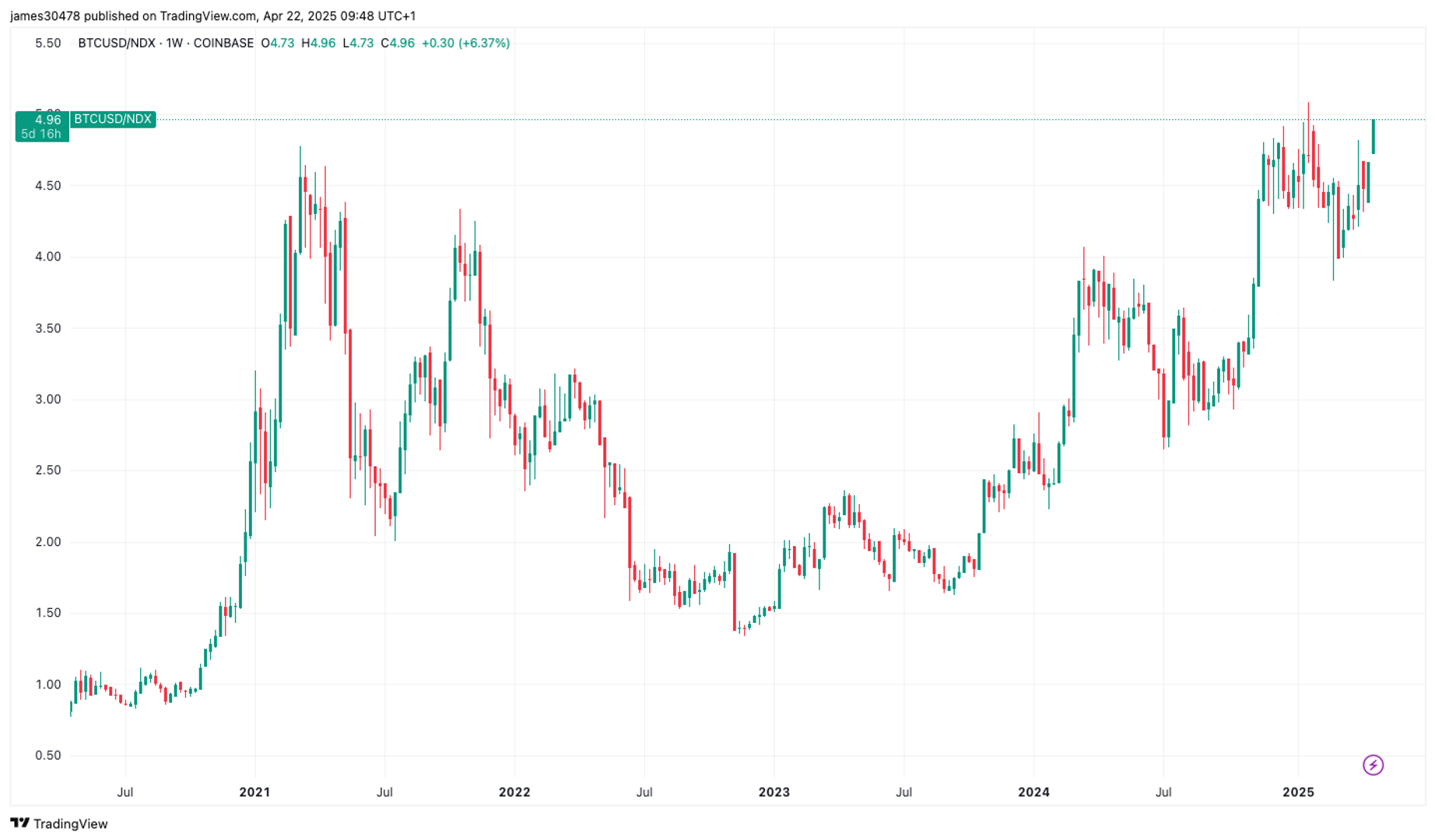Uncategorized
Bitcoin Miner Hut 8 Buys $100M BTC Boosting Total Total Stash to $1B

Another bitcoin miner, Hut 8 (HUT), has decided to pull the trigger on buying bitcoin in the open market, following the likes of MicroStrategy (MSTR) and MARA Holdings (MARA).
The Miami, Florida-based company said it bought about 990 bitcoin for an average price of $101,710 each. The latest purchase will bring the amount of bitcoin held in Hut 8’s reserve to 10,096, or about $1 billion in market value, and make it among the top 10 largest corporate owners of bitcoin, the company said in a statement on Thursday.
The miner is planning to use the reserve through options strategies, pledges, sales or other strategies, according to the statement. Hut 8’s CEO, Asher Genoot, told CoinDesk that his firm will be opportunistic in buying more bitcoin in the open market.
“Today, the market recognizes and values our strategic reserve, which effectively lowers our cost of capital and strengthens our financial position. As long as this market dynamic persists, we will remain opportunistic in expanding our Bitcoin reserve,” Genoot said.
The move follows Hut 8’s announcement earlier this month that it started a new $500 million at-the-market share issuance program. At the time, the firm said some of the proceeds from the fund would be used to buy bitcoin in the open market, among other things.
MicroStrategy, the largest corporate holder of bitcoin on its balance sheet, started the trend of buying bitcoin in the open market. It wasn’t until MARA Holdings’ purchase of bitcoin in the open market this year that this became prominent among the miners. Most recently, peer Riot Platforms (RIOT) bought 667 bitcoin at an average price of $101,135 on Dec. 16.
Buying large amounts of bitcoin in the open market has paid off for miners opening up new avenues of raising funds at a time when the industry is grappling with a profit squeeze after the recent Bitcoin halving event. Last month, MARA was able to raise $1 billion in convertible debts—a financial instrument where investors can convert debt into equity—with zero interest. This means investors are willing to let go of the interest income from the debt for the equities that provide them with exposure to bitcoin.
Hut 8 said holding bitcoin reserve serves as a flexible option for the firm that can help the company grow. «We view our strategic reserve as a dynamic financial asset that can be actively managed to drive returns well beyond simple price appreciation,» Genoot told CoinDesk.
«Together with the significant investments we are making to expand our core operating business—with a clear path to 24 EH/s of self-mining capacity by Q2 2025—strategic Bitcoin purchases in the open market can strengthen our balance sheet and ability to invest thoughtfully in growth,» he said.
Shares of Hut 8 have risen 74% this year, while CoinShares Valkyrie Bitcoin Miners ETF (WGMI) climbed 28%.
Uncategorized
Bitcoin Closing In on Historic Breakout vs Nasdaq

Bitcoin (BTC) is on the cusp of breaking out relative to the Nasdaq 100 Composite, with the current BTC/Nasdaq ratio sitting at 4.96. This means it now takes nearly five Nasdaq units to match the value of one bitcoin. The previous record of 5.08 was set in January 2025, when bitcoin hit its all-time high of over $109,000.
Historically, each market cycle has seen the ratio reach new highs—2017, 2021, and now 2025—highlighting bitcoin’s continued outperformance against the Nasdaq.
Across multiple timeframes, bitcoin is increasingly diverging from U.S. tech stocks. Year-to-date, bitcoin is down just 6%, compared to the Nasdaq’s 15% decline. Since Donald Trump’s election victory in November 2024, bitcoin has rallied 30%, while the Nasdaq has fallen 12%.
When measured against the «Magnificent Seven» mega-cap tech stocks, bitcoin remains around 20% below its all-time high from February this year. This indicates that while bitcoin has shown strength, the top tech names are holding up better than the broader Nasdaq Composite.
Strategy (MSTR), a well-known proxy for bitcoin exposure, is also holding up better than the U.S tech stocks. Since joining the QQQ ETF on Dec. 23, MSTR is down 11%, while the ETF itself has dropped over 16%. The divergence has become more pronounced in 2025: MSTR is up 6% year-to-date, compared to QQQ’s 15% decline.
Uncategorized
Bitcoin Runs Into Resistance Cluster Above $88K. What Next?

This is a daily technical analysis by CoinDesk analyst and Chartered Market Technician Omkar Godbole.
Bitcoin’s (BTC) bullish advance has encountered a resistance zone above $88,000, marked by crucial levels that could make or break the ongoing recovery rally.
The resistance cluster’s first and perhaps most critical level is the 200-day simple moving average (SMA) at $88,356. The SMA is widely regarded as a key indicator of long-term momentum. Early this month, Coinbase institutional analysts called the downside break of the 200-day SMA in March a sign of the onset of a potential crypto winter.
So, a fresh move above the 200-day SMA could be taken to represent a renewed bullish shift in momentum.
Such a move would trigger a dual breakout, as the Ichimoku cloud’s upper end is located close to the 200-day SMA. A move above the Ichimoku cloud is also said to reflect a bullish shift in momentum.
Developed by a Japanese journalist in the 1960s, the Ichimoku cloud is a technical analysis indicator that offers a comprehensive view of market momentum, support, and resistance levels. The indicator comprises five lines: Leading Span A, Leading Span B, Conversion Line or Tenkan-Sen (T), Base Line or Kijun-Sen (K) and a lagging closing price line. The difference between Leading Span A and B forms the Ichimoku Cloud.
The third and final level forming the resistance cluster is the high of $88,804 on March 24, from where the market turned lower and fell back to $75,000.

A make-or-break resistance zone?
Behavioural aspects of trading come into play when an asset approaches a resistance zone, especially at key levels like the 200-day SMA and the Ichimoku cloud.
Prospect theory suggests that people are typically risk-averse with respect to gains and risk-seeking with respect to losses, known as the “reflection effect.» So, as traders, people tend to be risk-averse while locking in profits and keep losing trades open.
This tendency is amplified when an asset encounters a significant resistance zone. Traders who entered the bitcoin market around $75K, anticipating a rebound, may feel pressured to take profits as the price approaches this resistance. Such selling could, in turn, slow the price ascent or even trigger a new downturn.
Conversely, if bitcoin successfully breaks through the resistance zone, the fear of missing out could prompt more traders to make bullish bets, further fueling bullish momentum and pushing the price higher.
Uncategorized
Bithumb to Split in Two as Crypto Exchange Inches Toward South Korean IPO

Bithumb plans to split its core crypto exchange business from other activities as it reorganizes in preparation for an initial public offering (IPO).
The Seoul-based company will split in two, with Bithumb Korea focusing solely on operating the core crypto exchange business. Bithumb Korea will be the entity seeking a public listing, local media reported, citing the country’s corporate registry.
The other unit, a newly created company called Bithumb A, will oversee venture investments, asset management and new business initiatives. The restructuring is set to take effect on July 31.
Bithumb A will consolidate the exchange’s investment arms, including Bithumb Partners, which has shifted from NFT and metaverse projects to financial product investments such as equities, bonds and convertible bonds. According to local media, Bithumb is in talks with licensed entities to offer these services in the country.
Bithumb Investment, which manages equity stakes and strategic partnerships with external companies, will also fall under Bithumb A’s oversight.
Last year Bithumb was said to be considering a NASDAQ listing, but now its plans have shifted to a listing on South Korea’s Kosdaq first, with a U.S. listing as a secondary objective.
Bithumb posted an operating profit of 130.8 billion won ($95 million) in 2024, reversing a 149 billion-won loss from the previous year, local media reported.
-

 Fashion6 месяцев ago
Fashion6 месяцев agoThese \’90s fashion trends are making a comeback in 2017
-

 Entertainment6 месяцев ago
Entertainment6 месяцев agoThe final 6 \’Game of Thrones\’ episodes might feel like a full season
-

 Fashion6 месяцев ago
Fashion6 месяцев agoAccording to Dior Couture, this taboo fashion accessory is back
-

 Entertainment6 месяцев ago
Entertainment6 месяцев agoThe old and New Edition cast comes together to perform
-

 Sports6 месяцев ago
Sports6 месяцев agoPhillies\’ Aaron Altherr makes mind-boggling barehanded play
-

 Business6 месяцев ago
Business6 месяцев agoUber and Lyft are finally available in all of New York State
-

 Entertainment6 месяцев ago
Entertainment6 месяцев agoDisney\’s live-action Aladdin finally finds its stars
-

 Sports6 месяцев ago
Sports6 месяцев agoSteph Curry finally got the contract he deserves from the Warriors





